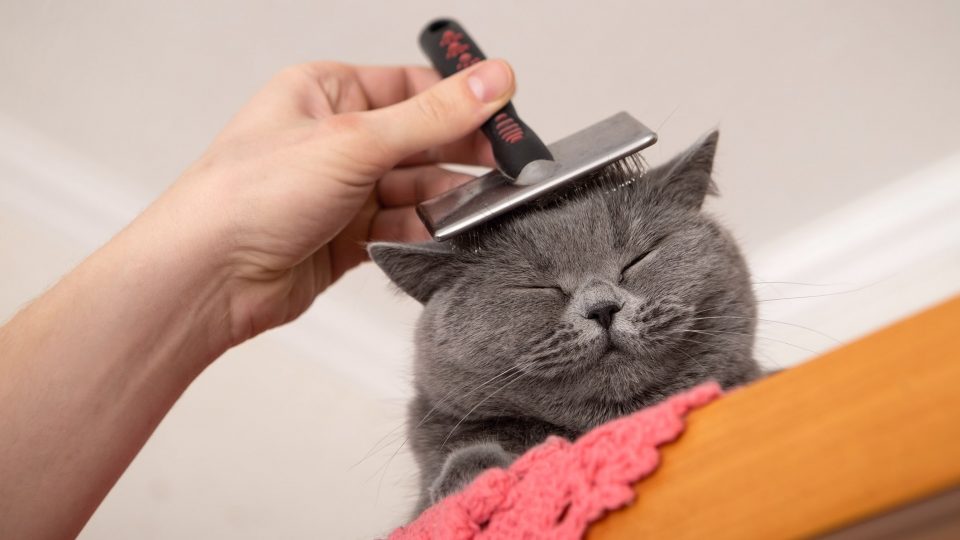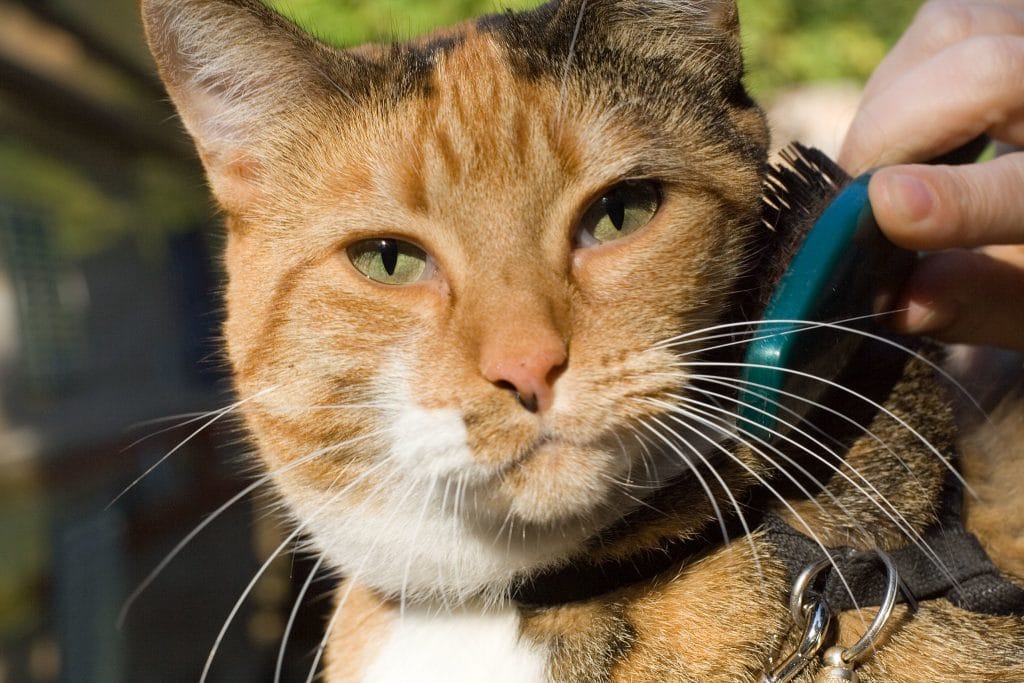Cats are impeccably clean by nature. They groom themselves meticulously to ensure that every hair is in place, and for the most part, need little to no help from their human companions to keep themselves flawless.
There are some times when your cat may need a little bit of help, though. Whether they have long hair prone to matting, are old or otherwise unable to reach every spot, or simply landed in a sticky mess—don’t worry.
We’ll walk you step-by-step through every aspect of cat grooming from dealing with matted fur to the dreaded (but sometimes necessary) bath.
Whether your cat just needs a trim of their nails or the full spa works, pay close attention to their body language.
All cats are different, and some tolerate human grooming intervention better than others. If your cat is resistant or becomes too uncomfortable (or scratchy), consider trusting their care to an experienced groomer for both your safety.
On the other hand, if your cat is purring and rubbing up against the brush, you won’t want to leave them hanging.

iStock/amandafoundation.org
Trimming Your Cat’s Nails
You may have seen your cat digging their claws into a scratching post—or even a piece of furniture. This is your cat’s way of maintaining their nails to keep them short, sharp, and healthy.
If your cat needs a little help with this, or if they keep their claws a bit sharp for your tastes, you can trim them yourself. It just takes patience and attention to detail.
Before you get started trimming nails, though, the ASPCA recommends getting your cat used to the clippers and to having their feet touched. Not sure what clippers to use? We like these pet nail trimmers from H&H.
How to get your cat used to having their paws handled
Take time to hold them in your lap a week or two before clipping their nails. Pet them and let them get comfortable and sleepy.
Once they are relaxed, run your hand lightly over each leg and gently massage their paws for up to three seconds at a time.
When your cat is used to this, gently press their paw to extend the claws, then reward your cat with a treat. This helps to make handling their paws (and claws) a positive experience rather than a stressful one.
How to get your cat used to nail clippers
The ASPCA recommends sitting your cat on your lap with treats and a piece of uncooked spaghetti on hand. Let your cat sniff the clippers and give them a treat if they do.
Touch and gently massage your cat’s paws like before, and this time clip a piece of the uncooked spaghetti with the clippers at the same time to simulate the sound of nails being cut.
Give your cat a treat after each time to show your cat that this can be a positive experience.
Repeat this a few times to get your cat used to the sound and smell of the nail clippers.
OK, got your cat all comfortable? Here’s how to clip your cat’s nails effectively.
1. Consider picking up some styptic powder
WebMD suggested using styptic powder to stop the bleeding if you accidentally cut the quick—the pink vein visible inside of the nail. You should try to avoid the quick while cutting your cat’s nails, but it isn’t a bad idea to pick up some styptic powder to have on hand, just to be safe.
2. Pick a quiet place
Once your cat is used to having their paws handled and used to the nail clippers, it’s time for the real deal. Sit down with your cat in your lap in a quiet spot away from any windows or other distractions and let your cat get comfortable.
3. Bring those claws out
Once they are relaxed, pet their legs and feet to ease them into the process, then gently take one paw in hand. Apply gentle pressure to the pad and the top of the foot to extend the claws.
4. Locate the quick of the nail to avoid cutting it
Before you even start cutting, look for the pink area of the nail—the quick. Avoid cutting in this pink area.
Carefully cut off only the white tip of each nail, right before it starts to curl. Take care to avoid cutting into the pink quick of the nail. Repeat this for each nail.
If you do accidentally cut into the pink quick, it can bleed. If this happens, WebMD recommends applying styptic powder to stop the bleeding.
5. Don’t do it all at once
Clipping your cat’s nails is a lot more stressful when you sit down and trim nails all at once. Instead, try to space out sessions. Sit down and do one paw. A little later, trim the nails on another paw.
6. Reward your cat
This is arguably one of the most important steps in the process. Be sure to reward your cat with a treat, lots of praise, and attention (if they want it) after a nail trimming session. It can be a scary experience for them, especially the first time, so it’s essential to show your cat that everything is okay, and that they did a great job.
Important: Don’t declaw your cat!
The ASPCA highly discourages declawing cats, since this is an amputation surgery that removes the end of your cat’s toes. If you are struggling with trimming your cat’s nails, consider taking them to an experienced groomer. If your cat likes to shred the furniture, give them scratching posts that they can run their claws over instead. You can also look into nail caps, or an anti-scratch spray to deter your cat from scratching the furniture.
Once you’ve mastered trimming your cat’s nails, you’ll find it easy to learn some of the other grooming techniques for cats.
Brushing Your Cat
Brushing is one of the best ways to keep your cat looking and feeling great. It removes dirt and particles from the fur, spreads natural oils throughout the coat, and helps to prevent tangles or matting.
Long-haired and short-haired cats both benefit from regular brushing but may have different needs. The ASPCA recommends brushing long-haired cats every few days and brushing short-haired cats once per week.
A few tips for brushing your cat:
1. Choose the best brush for your cat
A metal brush works well for short-haired and long-haired cats (even Persians and Maine Coons) and is the best at removing debris and untangling fur. On the other hand, rubber brushes are excellent choices for removing loose hair on short-haired cats.
Just like with the nail trimmers, let your cat sniff and investigate the brush before you even start. Reward them with a treat and praise.
2. Brush in the direction of your cat’s fur
Time to start brushing! Pay close attention to which direction your cat’s fur grows in each area and work the brush through their fur gently.
Brush all over their body, concentrating on one area at a time, and don’t forget the chest and abdomen. Comb neck fur upward toward the chin, and for long-haired cats part the tail to brush the fur out to either side.
Carefully work out any knots or mats. The ASPCA recommends sprinkling talcum powder over the spot and gently easing the knot apart with your fingers. If this still doesn’t loosen the knot, consider trying a mat-splitter on the spot.
3. Check your cat’s skin and body with a gentle petting session
Once a week, when brushing is all finished, the ASPCA recommends taking some time to check for hidden tangles, wounds, bumps, and anything else out of the ordinary.
Check for ticks and flea dirt (black specks of dry blood left behind by fleas).
Check under your cat’s tail, as well. Keep an eye out for any feces that have become lodged in fur and need to be snipped away using scissors, or any tan-colored, rice-shaped objects around your cat’s rear that may be a sign of worms.
Brushing your cat regularly helps to avoid painful tangles and means fewer hairballs for your cat. Of course, other situations can cause hairballs—so if your cat continues to suffer from them despite regular brushing, then it’s time to talk to your vet.
Although brushing can be scary at first, many cats love the attention! Reward your cat regularly with treats after brushing to help them think of this as a positive experience.
After a few regular brushing sessions, you may find that they start to look forward to being brushed!
Grooming an Older Cat
As cats get older, it gets harder for them to groom themselves and keep their fur and skin in top shape. This could be due to arthritis, decreased mobility, and increased oil production from the skin, which causes mats, according to PetMD.
Because of this, these older cats need a little extra help from their human companions.
Regular brushing is essential for all cats, but it is especially important for older cats.
Try to make this a positive experience by petting your cat while brushing them, offering lots of praise, and giving them treats throughout the session. While brushing, be sure to use gentle, slow movements and consider using a brush with soft bristles instead of wire bristles for the sake of sensitive joints and skin.
Remove mats as needed. If the above advice about using talcum powder for mats doesn’t work, they’ll need to be cut out. Because older cats have such paper-thin skin, PetMD recommends taking your senior cat to an experienced groomer to remove these mats for their safety.
As cats get older, their claws grow thicker, and the outer layer of the nail sheds less often. Because of this, they can be prone to ingrown or painful nails. PetMD recommends clipping your older cat’s nails once per month.
Bathing Your Cat
Your cat works hard to keep themselves clean, but sometimes life happens. If your cat gets into a sticky, smelly, or dirty situation, it might be time for the dreaded bath. Although some cats enjoy the water, many do not. These steps will help this process to be as easy and painless as possible for you and your cat.
- Do a bit of grooming before bathing, if possible. For your safety, it may be a good idea to trim your cat’s claws beforehand. And, if possible, take a moment to brush them to remove any dead hair or mats.
- Plan bath-time for when your cat is calm. The ASPCA recommends a vigorous play session with your cat’s favorite toy to tire them out before bathing. Give them a few moments to rest and calm down after play, and then get the bath ready.
- Start the water and use a rubber mat in the sink or tub. This will help to keep your cat from slipping and keep their stress at a minimum. Then, fill the sink or bathtub with three or four inches of lukewarm water. Avoid hot or cold water with baths, and instead, opt for something closer to room temperature.
- Carefully place cotton in your cat’s ears. This will help to keep water out of their ears while bathing.
- Use a spray attachment or cup to wet your cat. Gently place your cat in the sink or tub and use a spray nozzle or a cup to wet your cat’s fur. Avoid splashing water directly in the eyes, ears, and nose.
- Dilute cat shampoo and massage it directly into the fur. The ASPCA states that human shampoo can dry out feline skin, and instead recommends diluting one part of cat shampoo into five parts of water and massaging it into your cat’s fur. Start at the head and work towards the tail, massaging in the direction of the fur. Avoid getting shampoo in the face or ears.
- Rinse off! Once you’ve worked the dilute shampoo mixture all over your cat’s body, rinse it off with the spray hose or cup. Make sure the water is lukewarm, like the bath, and rinse thoroughly to remove any irritating shampoo residue from your cat’s skin.
- Gently wash the face. Plain water and a washcloth are usually sufficient to gently wipe down your cat’s face. If they are extra dirty, you can use an even more diluted solution of shampoo—just take care to avoid the ears and eyes and afterward wipe down with a fresh, clean washcloth wetted with plain water to wipe away any residue.
- Dry and detangle. Now that bathing is done, it’s time to dry off your cat and get them back to what they love. Wrap them up in a large towel in a warm place and gently massage them dry. Pet hair dryers can cut drying time substantially, leading to a warmer, happier cat faster. The ASPCA also recommends taking a wide-toothed comb and running it through the fur to work out any tangles.
- Reward your cat! A bath can be a stressful experience for cats, so it’s important to give lots of praise and a favorite treat afterward.
Whether your cat just needs their nails trimmed or the whole spa works, we hope this guide gives you the knowledge and confidence to regularly groom your cat and help them look as good as they feel.




